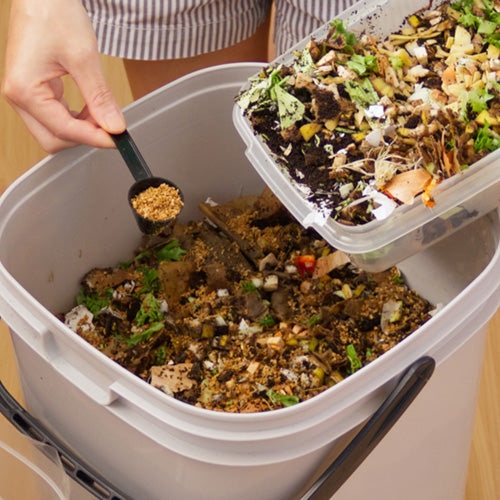One of the most underrated forms of climate activism is home composting. Composting is the natural process of recycling organic waste into a nutrient-rich soil fertiliser that returns nutrient goodness back into the soil.
The big ol’ problem is that when we send organic waste (e.g., food scraps) to landfills, it doesn’t decompose in an environmentally friendly way. Due to the lack of oxygen in landfills, organic waste very slowly breaks down in landfills into methane gas which is 25 times better at trapping heat in our atmosphere (though less long-lived than carbon dioxide).
Home composting is an easy solution – it's easy, good for our gardens, good for the environment and doesn’t cost a thing. You don’t need to have a farm or large garden to compost at home, it is just as easy to compost in an apartment. If you have food waste, there are many different ways you can utilise it, without sending it to landfill.

A Project Drawdown report indicates that organic waste makes up a whopping 46% of all global solid waste, contributing “469 tons of CO2 equivalent greenhouse gases per million metric tons."
If we skip the landfill and compost our organic waste, the report shows that composting has the ability to reduce those emissions by 50%.
This handy composting guide is great if you are new to home composting or are looking for some tips to extend your efforts.
What is composting?
Composting is basically the process of recycling organic waste. Organic waste is anything that comes from a plant or animal and can be broken down by microbes (biodegradable). Meat, veggies, bread, milk – it can all be composted. You can put all kinds of household organic waste into your compost solution - even paper and wood ash.
The benefits of compost
Compost is naturally nutrient-rich and can improve the quality of your soil while helping to improve soil drainage and water retention. Compost makes soil healthy and creates the perfect environment for roots to grow strong and thrive by adding back nutrients like nitrogen and carbon.
Using compost can reduce the need for synthetic fertilisers and introduces vital microorganisms, like bacteria and fungi, to the ecosystem of your soil - hello earthworms. It also reduces landfill waste and the production of toxic greenhouse gases.
Home composting versus commercial composting
Home composting and commercial or industrial composting is pretty much the same process. The difference is that industrial composting uses machinery and scale to create a lot of heat, resulting in a shorter processing time. Because of this, industrial composting can also process items that won’t fully decompose in a smaller scale system, for example ‘compostable’ plastics. So, if you are eating out of a take-away container that says ‘compostable’ but it doesn’t look like plain cardboard, check twice as it may only be commercially compostable and not something you can simply pop in your home compost.
Different methods of composting
From the classic countertop compost option to bokashi and vermicomposting (worm farms), there are lots of different composting options out there to suit everyone.
Popular methods of home composting include:
- Open-air composting
- Vermicomposting - great for apartment living
- Tumbler composting
- Japanese bokashi – another great option for apartment living
If we’re getting technical, bokashi is more fermenting than composting.
What can you home compost?
Depending on the type of home-composting method you choose the list of what you can and can’t include in your compost will change. However, as a general guide, here is a list of things you can and can’t compost.
Things you shouldn’t put in a home compost system
- Period products
- Baby’s diapers
- Human waste
- Synthetic fabric
- Glossy paper like wrapping paper
-
Diseased or pesticide-treated plants
What about mice and pests in your compost system? Like a garden, a compost system is a thriving ecosystem – mice included.
Read more in our Beginners guide to composting.
Things you might not know that you can put in your home compost
- Human hair
- Pet fur
- Brown paper products such as cardboard cartons, rolls, cereal boxes, and brown paper bags
- Ethique packaging - tubes, boxes - everything
- Coffee grounds and filters
- Plastic-free tea bags and tea leaves
- Cotton and natural yarn
- Lint from your vacuum cleaner
- Dryer lint provided it comes from natural and not synthetic fabric
- Newspaper and other plain paper – make sure it's not glossy
- Fruit and vegetable peelings
- Old fruit and vegetables
- Corn husks
- Natural loofahs
- Pinecones
- Natural wine corks - some are made of plastic so check beforehand
- Wood products like chips, matches, sawdust, wooden skewer sticks and toothpicks
- Tissues without human waste or non-biodegradable makeup
- Serviettes and paper towels
- Eggshells
- Grass clippings, leaves, yard trimmings
-
Animal droppings from herbivores such as rabbits, chickens, and guinea pigs
Green and Brown Waste
But wait, there’s more! There are two types of waste too.
What is Green waste?
Green waste is stuff like kitchen scraps - vegetable peelings, grass clippings, and other food waste that doesn’t include animal products, dairy or things like pasta or bread. It brings the heat to the composting process, which is essential to decomposition success.
What is Brown waste?
Brown waste additions are the carbohydrate and carbon-rich materials, like brown paper, cardboard, wood chips, sawdust, newspaper, corn husks, bark, and brown leaves. You can even add ash from your wood burner or BBQ, (just make sure the embers are completely cool before adding!) It is not recommended to add ash from coal or treated wood.
The compost pros say that the best type of compost for your garden is made from a combination of green and brown waste. 40% green waste and 60 % brown to be exact.
Compost pro tips:
Layer your green and brown waste like a sandwich for best results.
If your compost is smelly, add more brown waste to the mix to reduce the odour.
How do you know when your home compost is ready?
Outdoor and worm farm compost is typically ready when it is dark brown and crumbly with an earthy scent, it is ready to work its magic on your garden, tubs, pots and containers.
Bokashi is compost ready when your organic waste has the odour much like the one of homebrew beer – a yeasty, sweet, and sour pickle scent that isn’t smelly or too intense.
How long does it take for compost to be ready?
Different methods of home composting may yield different results. Aerobic composting provides additional aeration to open-air or outdoor bin options and can be ready to use in your garden in a matter of weeks. If left to its own devices at the bottom of a garden i.e., anaerobic compost heap that you never disturb, composting it could take up to 1 year.

 Impact
Impact Blog
Blog Store Locator
Store Locator


